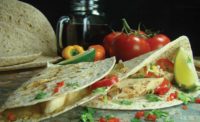Diameter, shape, opacity and shelf stability are critical product-quality factors for tortilla manufacturers. But their ingredients count to help make these factors work. Feliciano “Sonny” Bejosano, of Allied Blending & Ingredients Inc., looks at ingredients typically used in tortilla formulations and how they impact finished products.
Consumers, restaurateurs, in-store delis and other end users are continuing to find new and creative uses for tortillas, once considered a staple mainly in Mexican dishes. Tortilla manufacturers, in turn, are expanding their offerings, introducing products that are gluten-free, low-fat, low in carbohydrates, kosher and more. They’re also launching interesting flavors like spinach, cheese and black bean; and are making tortillas with non-corn grains, such as whole wheat, sprouted whole grains, spelt, oat and flax.
Just as consumers are looking to tortilla manufacturers for innovative new products to help them get creative in the kitchen, tortilla manufacturers are turning to their suppliers for ingredients to help them deliver superior products.
Feliciano “Sonny” Bejosano, Ph.D., a senior food scientist at Allied Blending & Ingredients Inc., Keokuk, IA, presented a seminar on ingredient functionality for tortilla improvements to attendees at the Tortilla Industry Association (TIA)’s Annual Convention & Trade Exposition in May in Las Vegas. Based at the company’s Bell, CA, facility, Bejosano oversees the Tortilla Innovation Center as well as develops and improves tortilla formulations.
Bejosano began his presentation with a brief overview of tortillas: Tortillas originated in Mexico, where they were made at home from four basic ingredients—flour, water, lard and salt—and consumed fresh. Eventually, they were produced and sold daily in small neighborhood shops.
Today’s tortillas are much more versatile than their four-ingredient predecessors, thanks to formulas and ingredients that help improve their taste, pliability and shelf life. Today’s commercial flour tortilla formula still comprises flour (60%), water (29%) and shortening (6%), but it usually also contains a batch pack (5%) containing salt, sugar, leavening, dough conditioners and preservatives, according to Bejosano. During his TIA presentation, he examined each component and its role in tortilla formulations.
Flour factors
Flour quality depends on gluten quantity and strength, according to Bejosano. Bread formulations require strong gluten. Cakes, pastries and similar products require weak gluten, which has less protein and less strength. Tortillas, meanwhile, require “mellow” gluten flour—flour that’s enriched and lightly bleached. The flour quality table shown (page TT-10) offers a comparison of flour quality criteria for bread (as per researchers V.F. Rasper and C.E. Walker) and suggested specifications for hot-press tortillas.
A variety of flour additives also allow tortilla manufacturers to produce superior tortillas. Riboflavin, niacin, biotin, folic acid and iron are some of the nutrients they commonly use to enrich flour to create more nutritious products.
According to Bejosano, most of the flours currently available contain oxidants, which act as bleaching agents and remove the natural yellow pigment from flour. They also add strength to gluten.
Benzoyl peroxide and azodicarbonamide (ADA) are commonly used oxidants. (Some tortilla manufacturers are no longer using ADA in their products due to negative consumer feedback. ADA is also used in foam plastics.) Potassium bromate, another oxidant, is banned in many countries. While the Food and Drug Administration (FDA) hasn’t officially banned potassium bromate, it suggests food producers use alternatives.
In addition to enabling tortilla manufacturers to make their products more nutritious and visually appealing, some flour additives also improve dough functionality. These include barley malt, commercial enzymes and enzymes that hydrolyze starch, proteins, fiber and fat. Chlorine, ascorbic acid and lipoxygenase enhance gluten formation, strength and stability.
Some flour oxidants also act on the sulfhydryl groups in flour protein, affecting their functionality and causing “maturation.” (To mature naturally, flour must be exposed to oxygen in the air.) ADA is a maturing agent, while benzoyl peroxide is a bleaching agent. Chlorine and chlorine dioxide are both bleaching and strong maturing agents.
Additives can also make the gluten matrix stronger or weaker. Because fluffy dough texture depends on the retention of steam and leavening gases by the gluten matrix, the formation of the matrix is of utmost importance.
Bejosano reminded presentation attendees that adding anything to the dough can change its structure and affect the texture and quality of the tortilla.
Water and shortening
The second major ingredient (29%) in tortilla production is water, said Bejosano. It’s required for dough formation, the distribution and activation of other ingredients and starch gelatinization.
Tortilla dough contains less water and more fat than bread dough, so the gluten is not as fully developed in the former. The amount of water used when making tortillas determines the moisture content of the finished product. The optimum target moisture is 29-32%. Less moisture will cause a dry, crumbly product. Higher moisture causes high-water activity, causing tortillas to grow mold quickly and stick together inside the package.
Tortilla manufacturers use either solid shortening or liquid oils in their formulations. The latter facilitate a shorter mixing time and result in softer dough. Unmodified oils have lower melting points than solid fat shortenings and tend to produce tortillas with softer texture. Hot-press conditions should be adjusted accordingly.
The amount and type of shortening used affects dough machinability, dough stickiness, tortilla texture and tortilla flavor. Because shortening interacts with starch and proteins, it also slows staling.
Batch-pack components
Batch-pack components—salt, sugar, leavening, preservatives and dough conditioners—comprise about 5% of a commercial flour tortilla formula, said Bejosano. Ingredient suppliers typically offer custom packs created to meet customers’ specific needs, requiring them to just add flour, water and shortening.
Salt adds flavor to tortillas and enhances their shelf life. In addition, it interacts with gluten, making the dough stronger and less sticky. It also tightens up dough, thus increasing mixing time.
Sugar adds flavor to tortillas and contributes to “toast points,” the brown burn spots on tortillas. All baked foods are leavened by air, steam, thermal expansion and biological or chemical methods, according to Bejosano. “Using the right chemical leavening system is critical because most consumers prefer fluffy, thick, opaque tortillas,” Bejosano explained.
Chemical leavening systems are composed of a leavening base and acid. Sodium bicarbonate (NaHCO3) is the most widely used leavening base and chemically neutralized by an acid. Potassium bicarbonate is a low-sodium leavening base.
Leavening acids include sodium aluminum sulfate (SAS), sodium aluminum phosphate (SALP), sodium acid pyrophosphate (SAPP), monocalcium phosphate (MCP), calcium acid pyrophosphate (low sodium). Of these, SAS, SALP, SAPP and MCP are commonly used in flour tortillas.
Citric acid and fumaric acid are also used in flour tortilla formulations. Citric acid is soluble in water and reaches an equilibrium pH in the mixer. As a result, most of the sodium bicarbonate is expended in the mixer, with little remaining for leavening in the oven. This results in translucency in the finished product. Fumaric acid, on the other hand, is less soluble than citric acid and does not cause as much translucency.
All acids react with, or neutralize, sodium bicarbonate, form carbon dioxide and lower the pH in the dough. When acids that are less soluble in water—SAS or fumaric acid, for instance—are used, the reaction rate is lower, so it may take several hours or days for tortilla dough or baked tortillas to reach equilibrium pH.
Preservatives
For most tortilla producers and consumers, the days of making, selling and consuming fresh tortillas daily are gone. Ready-to-eat tortillas in resealable bags enable end users to refrigerate or freeze tortillas until needed.
Tortilla manufacturers, therefore, rely on a variety of preservatives to keep their products fresh in the interim: Calcium propionate; sodium propionate; potassium sorbate; sorbic acid; sodium benzoate; methyl/propyl parabens; and cultured wheat flour (clean label).
The most common anti-mold agents used in tortillas are calcium propionate, sodium propionate and potassium sorbate. Their activity is pH dependent. To attain the desired pH level, tortilla manufacturers use acidulants, such as fumaric acid, citric acid, malic, acid and glucono delta lactone.
However, acids directly affect dough and tortilla properties. More soluble acids, for instance, toughen dough and make it difficult to press, resulting in small-diameter tortillas. Manufacturers should choose less soluble acids to minimize this effect.
Fumaric acid is preferable for tortilla formulations because it’s less soluble in dough and interferes less with the leavening reaction than acids that become soluble during mixing.
Dough conditioners
Emulsifiers act as dough conditioners in two ways: They increase the amount of binding sites that gluten strands have to each other; and/or form bridges to supplement disulfide linkages, which results in a stronger gluten film. They also form ordered structures with water, thereby supporting lipids in the dough system.
Common emulsifiers are sodium- and calcium stearoyl lactylate (SSL and CSL), ethoxylated mono- and diglycerides (EMG), polysorbates (PS), succinylated monoglycerides (SMG) and diacetyl tartaric acid ester of monoglycerides (DATEM).
Emulsifiers offer tortilla manufacturers a variety of benefits. They can be used to compensate for variations in raw materials; improve dough machinability by enhancing the incorporation of water, shortening and other functional ingredients; and enable dough to tolerate more abuse during production by providing a drier, less sticky dough.
Emulsifiers make it easy for manufacturers to formulated low-fat products by reducing the amount of shortening or oil in a recipe without significant product quality loss. They also produce finished products with better texture and fewer deformed products.
Emulsifiers can also decrease product staling and sticking. Those that function as starch-complexing agents—as crumb softeners—form complexes with starch molecules and interfere with starch recrystallization (or retrogradation), which retards the firming rate. One of the best starch-complexing agents for all baked goods, according to Bejosano, is a dispersible form of distilled monoglycerides.
Gums and fibers
Two other dough conditioners often used in tortilla formulations are gum and fibers. Gums, or hydrocolloids, can be used as fat replacers, water binders, texturizers and adhesives. Hydrocolloids form macromolecular networks in the water phase of the dough or batter, and significantly increase its viscosity and/or elasticity.
Commonly used gums are guar gum, carboxymethyl cellulose (CMC) gum, xanthan gum, carrageenan and sodium alginate. Guar gum is the most common hydrocolloid used in tortilla processing because it improves dough and finished product quality; provides moisture retention, strength and pliability; and prevents tortillas from sticking together.
Numerous guar gum alternatives are available, but not all are suitable for tortillas. Locust bean and tara gums prevent tortilla sticking, while CMC and xanthan gum also provides some degree of positive effect. Combined, however, they lose the ability to control sticking. Bejosano says alginate, psyllium and CMCar (a blend of CMC gum and carrageenan) are not suitable for tortilla applications because they don’t control sticking or intensify it.
Fibers are high molecular weight compounds such as powdered cellulose, soy fiber, oat fiber and inulin. They’re often classified into one of two categories: Insoluble, which doesn’t dissolve in water; and soluble, which does. Bakers often add insoluble fibers to baked goods to increase their fiber content for improved nutritional value. Soluble fiber dissolves in water to form a gel-like material. Most gums are considered soluble fibers.
Dietary fibers include all cellulose-rich parts of plant foods that the body cannot digest or absorb. They absorb water during dough mixing and retain it during baking, giving a moister final product with lower caloric density.
Enzymes and reducing agents
Enzymes are also functional ingredients used to improve tortilla dough quality. During cooking, starch components disperse in water, forming a soft pliable gel. As the gel ages, it becomes harder, the result of the starch components coming together again or recrystallizing. Amylase, an enzyme, breaks those starch molecules into pieces to an extent. It also slows down recrystallization and prevents the gel texture from hardening during storage.
Malt ingredients, which occur naturally in flours, contain high amounts of enzymes. Seed germination produces alpha amylases, protein enzymes that begin the starch digestion process.
Fungal amylase is alpha amylase from fungal sources. It’s mainly used to aid dough conditioning and acts on starches, but is not heat stable.
Bacterial amylase is more heat stable than fungal amylase and breaks down starch components even after baking. It’s used to prevent staling during storage. Maltogenic amylase and G4 enzyme are both from bacterial origins.
Reducing agents, also dough conditioners, weaken the gluten matrix by breaking down the protein bonds in dough. This reduces mixing times and dough elasticity, thus shortening the time needed to process the dough and facilitating the mechanical production of tortillas. L-cysteine and sodium metabisulfite are the most common reducing agents.
Too much reducing agent makes tortilla dough sticky, and the tortillas begin to crack and break during storage. To prevent this from occurring, tortilla manufacturers can reduce the amount of water in their formulation, Bejosano explained. Low levels of a reducing agent also result in a less flexible tortilla during storage. However, reducing agents are still needed during processing to achieve a softer dough, resulting in larger diameter and more opaque tortillas.
Bejosano reminds tortilla manufacturers that they should select ingredients to match their processing equipment and to target the quality of their finished products.
To learn more about new and improved ingredients for tortilla manufacturers, check out “Making better tortillas” on www.snackandbakery.com this month.











